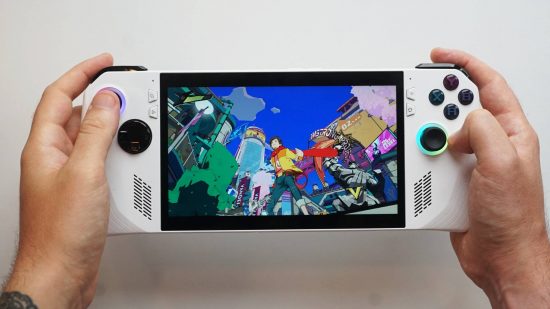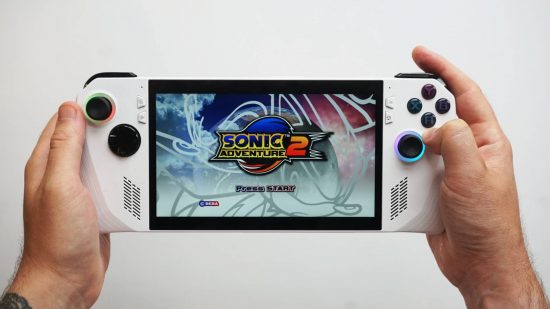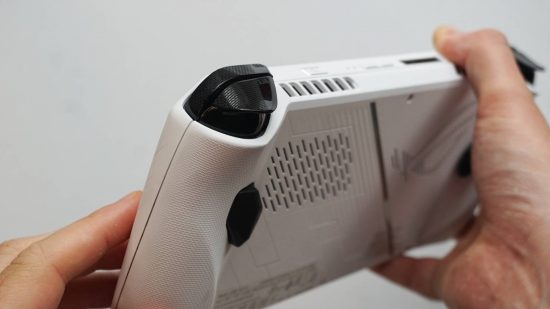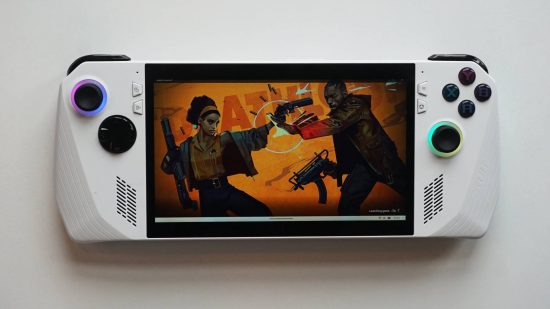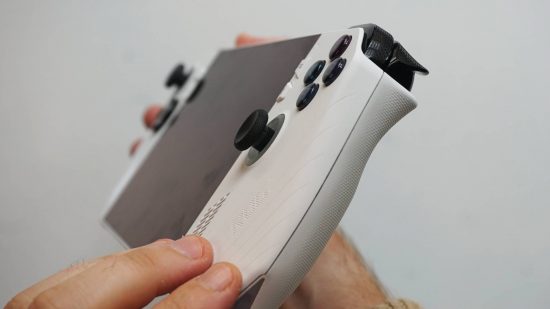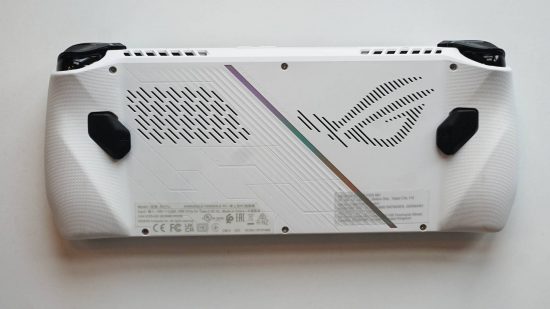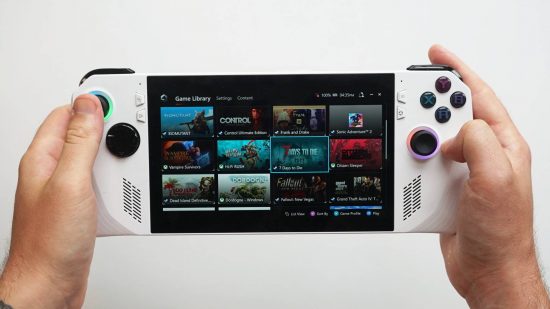Our Verdict
Consoles like the Switch and its walled garden ecosystem demand uniformity, but the ASUS ROG Ally is a confusing console, with launchers, updates, system settings, and graphic settings constantly getting in the way of the action. It’s powerful and gorgeous, but with such a poor battery life, it doesn't offer handheld gamers much over playing a PC except portability.
- Gorgeous screen and refresh rate
- Feels great to hold
- Impressively fast performance
- Disappointing battery life
- Windows is clunky to use handheld
The current handheld market is booming, and while the Nintendo Switch has its audience: two separate prongs are emerging. The compact and playful design of devices like the Playdate, the Ambernic RG35XX, and the Miyoo Mini are great for travel and ease of play. The Steam Deck occupies another end of the market, a high-end portable mostly designed for home use, but a convenient way to play your Steam library.
Then comes PC and phone manufacturer ASUS with the ROG Ally, a gaming device firmly in the powerful corner of the best portable gaming consoles camp. ASUS is billing the ROG Ally as a Steam Deck OLED killer, and the ambitious specs attempt to back this claim up. However, while the Steam Deck focuses on the best Steam Deck games (naturally), the ASUS ROG Ally is a full-blown Windows device, with all the possibilities and problems that entails.
The ASUS ROG Ally is a powerful portable Windows PC, with comfortable grips, a lush 7” inch 1920×1080 display, and a 120Hz refresh rate. This focus on power has several drawbacks, while the actual design of the ROG itself is a little ROG around the edges (sorry).
Why you can trust our advice ✔ At Pocket Tactics, our experts spend days testing games, phones, tech, and services. We always share honest opinions to help you buy the best. Find out how we test.
Features
ASUS offers two different SKUs of the ROG Ally, separated slightly by price and power. Both feature the 1080p 120hz 7” IPS-level screen, 512GB of internal memory, 16GB LPDDR5 onboard memory, and a 40WHrs, 4S1P, 4-cell Li-ion battery. However, the cheaper unit ($599.99) features a regular AMD Ryzen Z1 processor while the more expensive unit ($699.99) ships with the AMD Ryzen Z1 extreme processor.
Despite the superlative name, the difference between the regular Ryzen Z1 and the Ryzen Z1 extreme isn’t quite a gulf. Instead, games on the more expensive model are more likely to hit a stable 60 FPS. The basic model also boasts the same AMD Radeon graphics card as the more expensive unit, but the standard unit boasts 4 CUs up to 2.5GHz and 2.8 teraflops, while the $699 SKU uses 12 CUs up to 2.7 GHz and 8.6 teraflops. For the price, if you’re serious about your gaming it seems almost trivial to consider the basic option.
However, the basic version undercuts the most expensive Steam Deck ($649.99) while the more expensive unit tops it. We’re testing the $699 version of the ASUS ROG Ally and can attest that if you’re already spending this much money on the device, the more expensive option is the way to go for more reliable framerates in your games.
Design
Visually, if you don’t own a Steam Deck but do own a Switch, the leap here is a considerably large one. The ASUS ROG Ally’s 7” IPS-level screen is vivid, making games appear bright and detailed in a way leagues above the regular Nintendo Switch, but around as brilliant as the Nintendo Switch OLED Model. It’s also sharper than the Steam Deck and much sharper than the Switch, offering a possible 1080p over the Deck’s 800p.
One thing I like about the ROG Ally is the form factor. It’s a chunky unit, sitting at around 22mm thick, while the Switch OLED sits at 14mm, the buttons and the analog stick stretch this out even further. However, something I’m not as fond of is that the ROG Ally also weighs just over 600g. That weight isn’t bad considering just how much power ASUS packs in, but it’s a shame considering just how comfortable the rest of the device is.
The analog sticks feature a nice RGB ring around them that glows as you play, an entirely unnecessary addition but one that pleases my magpie brain to no end. The sticks feel like a rubber-based material and are comfortable and grippy for long sessions. The buttons feel plastic and quite clicky, and honestly a touch too small for the size of the device. Even just a little bit bigger would feel more natural for longer gameplay sessions.
There’s also a D-Pad on the left-hand side, though it apes the disc-like D-Pad of devices like the Xbox controller, instead of the separated D-Pad of the Steam Deck. You’ll sorely miss it in Street Fighter 6, but I doubt many are buying the ROG Ally to play fighting games competitively. For what it needs to do, the D-Pad works fine and doesn’t click too easily either, which is important when you need to use it to swap weapons or other finicky movements.
As a unit, the ROG Ally feels great to hold. The face buttons stick out nicely, and the shoulder buttons protrude enough that they’re comfortable to rest your fingers on but still have a satisfying click. There’s a slight slant on the back of the device as well which my hands naturally wrapped around, and even two additional buttons on the back of the device should you need them. You might get cramps in longer play sessions like I do, but there’s very little to complain about. Sure, I’d rather it was lighter and more comfortable, but this is a handheld PC at the end of the day.
Now while the ASUS ROG Ally’s performance is certainly ambitious, you won’t be running most games at 1080p 60fps, as that’s possibly a little too much for what even the high-end ROG Ally can achieve. In my tests, I had to knock games like Control, Deathloop, and Sea of Thieves down to 720 to achieve a stable 60fps and even had framerate wobbles in less demanding games like Casette Beasts.
Working as a Windows handheld, the ASUS ROG Ally offers somewhat disparate gameplay experiences, as I’m spending a lot of time in menus fiddling with visuals and framerates to achieve a consistent result. I sorely miss the uniformity of something like the Nintendo Switch, as I’m spending almost as much time adjusting settings as I am playing games.
You can choose to simply use the Windows desktop to host a series of launchers, but the ASUS ROG Ally does also boast the Armory Crate Launcher, a convenient place that collates all of your Steam, Xbox games, and games installed on the hard drive into one menu, all ready to launch.
One major draw over the Steam Deck is the ability to download Xbox games natively, instead of having to use Xbox GamePass Ultimate cloud streaming. The option to download and run GamePass games straight from the device is an absolute blessing, especially with longer games like Persona 4 or Sea of Thieves. Hopping between Xbox and the ROG Ally is easy to do with cloud saves, but you might quickly need more than the 512GB of internal memory that the ROG Ally offers.
Sadly, Steam games aren’t quite as simple though. Where the Steam Deck encourages developers to make games ‘Deck Verified’ to earn that all-important authentication badge, no such process of optimization exists for the ROG Ally. Hopping between games is a bit of a Wild West, and constantly fiddling with settings or launchers is a chore.
Not to mention, using the Windows desktop mode is unavoidable, and it’s a huge pain on the ROG Ally. While the 7” screen features ten-point touch controls, it is inevitably very fiddly having to mash your fingers around the miniature screen to select text boxes or explore the on-screen keyboard. You also constantly have to flit between the two, with touchscreen inputs the only way to unlock the device, before you use the buttons to control games.
You can plug a dock or external device into the ROG to use a keyboard and mouse, and even to use it as a desktop computer, but it’s neither a good desktop computer nor a convenient handheld console. The ROG boasts a USB-C port at the top for charging, and alongside this is a larger port where you can use a proprietary external GPU to improve the performance of the ROG Ally, effectively turning it into a powerhouse gaming computer.
ASUS calls this additional device the ROG XG Mobile, and it features an RTX 3080 that significantly boosts what the ROG is capable of, at the cost of being portable. Speaking of cost, the ROG XG Mobile also costs around $1400, so at this point, you’re well and truly better off buying a separate desktop PC for gaming. Plus, it negates the idea of the ROG Ally as a handheld device, and considering that’s how it’s billed, that’s how we’re judging it.
Performance
One thing the Windows architecture has over the Steam Deck is how easy it is to install and launch games unavailable on the Steam Deck and its Linux operating system. The ROG Ally allows you to launch Fortnite, Destiny 2, and Genshin Impact. Whether these few games and the ability to run Xbox games natively is a draw is entirely up to you, but the ROG Ally is at least carving out its corner of the market.
Remedy’s Control especially runs terribly before some serious fiddling in the settings, and other titles like Biomutant also need some drastic downscaling to get running in any playable state. It’s not a deal breaker, but considering the optimization that most titles go through to become Deck Verified, just remember, that while the ROG Ally might be more powerful on paper, optimization is half the battle.
Now, one way the ROG Ally really conveys its PC roots is its abysmal battery life. I get it, this is real power in your hands and there’s only so much you can fit into the device. However, when playing high-end games I’m genuinely lucky to get an hour of battery life. I know many say the Steam Deck doesn’t do much better, but it’s not an excuse. It makes a console billed as a handheld almost entirely tethered to a power outlet. I’d never think of taking this away with me to play games, this is a living room and bedroom-only device.
Also, the ASUS ROG Ally runs hot. Like, really hot. When pushing it for longer play sessions or playing more demanding games, the back of the device becomes really hot to touch. There are fans in there cooling it, but the harder they work the louder they are, making for an entirely unpleasant experience whenever you crank up the settings on your favorite graphical powerhouse.
I like the ROG Ally, but considering you can get a Steam Deck for under $500, and then an Xbox Series S for under $200 used, it’s genuinely hard to see just who this device is for. If you’re desperate to play some games locked out of the Steam Deck like Fortnite, then perhaps, but it’s certainly not worth the money or the headaches.
My time with the ASUS ROG Ally is constantly interrupted by screen tearing, stuttering, windows and launchers closing or freezing, updates, and even the BIOS menus launching and demanding I plug the device into the mains to provide essential maintenance.
The ASUS ROG Ally feels a little bit like Elton John. A dazzling display, and quite possibly the best at what it does, but an unruly diva in every other moment. Even simple games like Powerwash Simulator look frankly breathtaking on that vivid display, but the nuisance of getting it all running has put my Switch back in my hands several times.
If you’re a PC player, with a lot of Steam and Xbox games, and a lot of patience, then the ROG Ally could truly be the perfect device for you. The Windows system is a pain to navigate, but no more so than a PC. This is also a brilliant and very convenient way to collate several gaming libraries, which is currently impossible on most other handheld devices. The ROG Ally is good for very specific things, but it does them astonishingly well.
However, as a handheld, I’m so disappointed in the Ally. I don’t have the patience to adjust the screen resolution, performance, framerate, and countless other options for each game. I am constantly begging for the uniformity of the Switch gaming experience, and instead, I’m met with countless hurdles to my precious gaming time. Combined with a large size, heat problems, loud fans, and ridiculously poor battery life, this is not a console you want to take with you on the go.
The ASUS ROG Ally is an ambitious entry point into the handheld gaming space, and it’s certainly nipping at the heels of the Steam Deck. The ability to play a huge library of games is great, and playing Xbox games on the go is a blast. Plus, that gorgeous 7” display gives some games an amazing handheld conversion, allowing them to jump out of the screen thanks to that dazzling 1080p screen and a 120hz refresh rate.
However, you won’t spend most of your time playing games at full settings, and instead, you’re likely going to be gaming at around 720p to achieve an optimal gameplay experience. This combined with a confusing user interface, constant issues with the Windows infrastructure, the sheer amount of fiddling needed to get most games running, and a terrible battery life begs the question: should this even be a handheld device? Only you can answer whether it’s worth your money, but for now, I hope this is ASUS’ first step into a bold and bright future.
If you’re not sure whether the ROG Ally is for you, check out our guide to the best portable gaming consoles.
